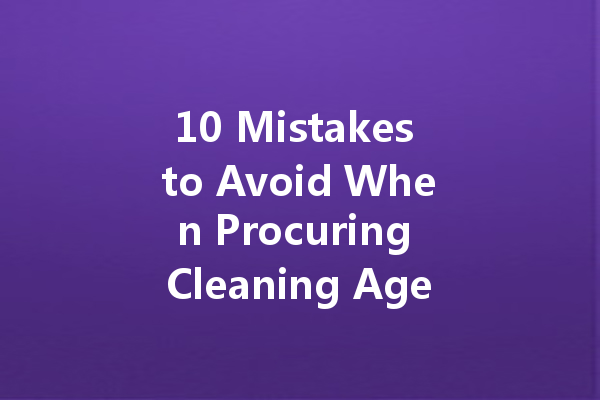In the world of cleaning, choosing the right cleaning agents is critical for maintaining a safe, hygienic, and efficient environment, whether it be in a commercial or industrial setting. However, businesses often make common mistakes during the procurement process that can lead to inefficiencies, additional costs, and compliance issues. This article outlines ten mistakes to avoid to ensure successful procurement of cleaning agents.
One of the primary mistakes businesses make is neglecting to analyze their specific cleaning needs. This involves understanding the types of surfaces that require cleaning, the nature of the contaminants, and the volume of cleaning necessary. Without a thorough assessment, businesses may end up purchasing cleaning agents that are ineffective for their specific requirements, leading to wasted resources and unsatisfactory cleaning results.
Cleaning agents come with various specifications, including pH levels, volatile organic compounds (VOCs), and compatibility with different surfaces. Ignoring these specifications can result in using products that may damage surfaces or fail to meet industry standards. It is essential to thoroughly review the product data sheets to ensure the cleaning agents align with your facility’s needs.
Another common oversight is neglecting the environmental impact of cleaning agents. Many businesses choose traditional cleaners without considering eco-friendly alternatives. This not only contributes to environmental degradation but may also require compliance with new regulations. Opting for biodegradable and non-toxic options can significantly enhance your corporate social responsibility and improve air quality in your facility.
The safety of employees should always be a top concern when procuring cleaning agents. Many cleaning products contain hazardous chemicals that can pose health risks. Businesses must evaluate the safety data sheets for each cleaning agent and provide proper training for staff on how to handle these chemicals, ensuring a safe working environment.
While looking for the most cost-effective cleaning agents, many businesses neglect to consider the total cost of ownership. This includes not just the purchase price but also factors such as disposal costs, storage, and potential liabilities related to use. A cheap initial investment may result in higher costs down the line, so it’s essential to evaluate the long-term implications of cleaning agent choices.

In the fast-paced world of procurement, communication with suppliers is vital. Failing to consult with suppliers before making purchasing decisions can result in missing out on valuable insights regarding product effectiveness, application techniques, and potential discounts. Building strong relationships with suppliers can lead to better deals and tailored product suggestions that meet your specific needs.
After procurement, it’s crucial to ensure that employees are trained in the proper use of cleaning agents. Many businesses fail to invest in staff training, leading to misuse of products and inefficient cleaning processes. Proper training programs should be implemented to educate employees on how to utilize cleaning agents effectively and safely.
Regulatory compliance is critical when procuring cleaning agents, particularly in industries such as healthcare and food service. Failing to stay updated on current regulations can lead to serious consequences, including fines and damage to your business’s reputation. Regularly review industry regulations and ensure that your cleaning agents comply to avoid pitfalls.
While cost analysis is an important component of procurement, businesses often make the mistake of relying solely on cost-benefit evaluations without considering other factors such as product efficacy and employee safety. A cleaning agent that is more expensive may provide significantly better results than a cheaper option. A comprehensive view that incorporates performance, safety, and environmental impact is essential when making procurement decisions.
Lastly, many businesses overlook the importance of monitoring the performance of the cleaning agents they procure. Failing to track how effective the chosen products are in maintaining cleanliness can lead to continued use of ineffective solutions. Implementing a system for regular evaluations of cleaning performance can help identify areas for improvement and guide future procurement decisions.
Conclusion
By avoiding these common mistakes in procuring cleaning agents, businesses can significantly improve their cleaning efficiency, reduce costs, and ensure a safe and healthy environment for all. A proactive and informed procurement strategy will lead to better product choices and ultimately contribute to a nettoyeur working space. Always remember to reassess cleaning needs, communicate with suppliers, and prioritize safety and effectiveness for long-term success.
